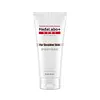What's inside
What's inside
 Key Ingredients
Key Ingredients

 Benefits
Benefits

 Concerns
Concerns

No concerns
 Ingredients Side-by-side
Ingredients Side-by-side

Water
Skin ConditioningSodium Lauroamphoacetate
CleansingSodium Methyl Cocoyl Taurate
CleansingSodium Chloride
MaskingCocamidopropyl Betaine
CleansingSodium Cocoamphoacetate
CleansingHydroxypropyl Starch Phosphate
Citric Acid
BufferingStyrene/Acrylates Copolymer
Acrylates Copolymer
Glycerin
HumectantPhenoxyethanol
PreservativePotassium Hydroxide
BufferingChlorphenesin
AntimicrobialDisodium EDTA
Butylene Glycol
HumectantTranexamic Acid
AstringentSodium Hyaluronate
HumectantHydrolyzed Collagen
EmollientDipotassium Glycyrrhizate
HumectantAlpha-Glucan Oligosaccharide
CleansingPanax Ginseng Root Extract
EmollientHouttuynia Cordata Extract
Skin ConditioningGinkgo Biloba Leaf Extract
Skin ConditioningVaccinium Myrtillus Leaf Extract
AstringentWater, Sodium Lauroamphoacetate, Sodium Methyl Cocoyl Taurate, Sodium Chloride, Cocamidopropyl Betaine, Sodium Cocoamphoacetate, Hydroxypropyl Starch Phosphate, Citric Acid, Styrene/Acrylates Copolymer, Acrylates Copolymer, Glycerin, Phenoxyethanol, Potassium Hydroxide, Chlorphenesin, Disodium EDTA, Butylene Glycol, Tranexamic Acid, Sodium Hyaluronate, Hydrolyzed Collagen, Dipotassium Glycyrrhizate, Alpha-Glucan Oligosaccharide, Panax Ginseng Root Extract, Houttuynia Cordata Extract, Ginkgo Biloba Leaf Extract, Vaccinium Myrtillus Leaf Extract
Water
Skin ConditioningLauramide DEA
Lauramine Oxide
CleansingDisodium Lauriminodiacetate
CleansingDisodium Lauryl Sulfosuccinate
CleansingSodium Cocoamphoacetate
CleansingTea-Cocoyl Glutamate
CleansingButylene Glycol
HumectantGlycol Distearate
EmollientPhenoxyethanol
PreservativeCitric Acid
BufferingPentylene Glycol
Skin ConditioningDipotassium Glycyrrhizate
HumectantSerine
MaskingEtidronic Acid
Rosmarinus Officinalis Leaf Oil
MaskingTocopherol
AntioxidantOlea Europaea Fruit Oil
MaskingRosmarinus Officinalis Leaf Extract
AntimicrobialWater, Lauramide DEA, Lauramine Oxide, Disodium Lauriminodiacetate, Disodium Lauryl Sulfosuccinate, Sodium Cocoamphoacetate, Tea-Cocoyl Glutamate, Butylene Glycol, Glycol Distearate, Phenoxyethanol, Citric Acid, Pentylene Glycol, Dipotassium Glycyrrhizate, Serine, Etidronic Acid, Rosmarinus Officinalis Leaf Oil, Tocopherol, Olea Europaea Fruit Oil, Rosmarinus Officinalis Leaf Extract
 Reviews
Reviews

Ingredients Explained
These ingredients are found in both products.
Ingredients higher up in an ingredient list are typically present in a larger amount.
Butylene Glycol (or BG) is used within cosmetic products for a few different reasons:
Overall, Butylene Glycol is a safe and well-rounded ingredient that works well with other ingredients.
Though this ingredient works well with most skin types, some people with sensitive skin may experience a reaction such as allergic rashes, closed comedones, or itchiness.
Learn more about Butylene GlycolCitric Acid is an alpha hydroxy acid (AHA) naturally found in citrus fruits like oranges, lemons, and limes.
Like other AHAs, citric acid can exfoliate skin by breaking down the bonds that hold dead skin cells together. This helps reveal smoother and brighter skin underneath.
However, this exfoliating effect only happens at high concentrations (20%) which can be hard to find in cosmetic products.
Due to this, citric acid is usually included in small amounts as a pH adjuster. This helps keep products slightly more acidic and compatible with skin's natural pH.
In skincare formulas, citric acid can:
While it can provide some skin benefits, research shows lactic acid and glycolic acid are generally more effective and less irritating exfoliants.
Most citric acid used in skincare today is made by fermenting sugars (usually from molasses). This synthetic version is identical to the natural citrus form but easier to stabilize and use in formulations.
Read more about some other popular AHA's here:
Learn more about Citric AcidDipotassium Glycyrrhizate comes from licorice root.
Extracts of licorice have demonstrated to have antibacterial, anti‐inflammatory, antiviral, antioxidant properties.
One component, glabridin, has extra potent antioxidant and soothing properties. It has also been found to block pigmentation from UVB rays in guinea pigs.
Licorice Root also contains a flavonoid. Flavonoids are a natural substance from in plants. Flavonoids also have antioxidant properties.
Another component, glycyrrhizin, has been found to have anti-inflammatory and antimicrobial benefits. This may make licorice root extract effective at treating acne. However, more research is needed to support this.
Liquiritin is one of the flavone compounds found in licorice. It has been found to help lighten skin by preventing tyrosinase from reacting with tyrosine. When the two react, protein is converted to melanin. Melanin is the substance in your body that gives your features pigmentation.
Licorice root is native to Southern Europe and Asia. It has been used in traditional Chinese medicine to help with respiratory issues.
Learn more about Dipotassium GlycyrrhizatePhenoxyethanol is a preservative that has germicide, antimicrobial, and aromatic properties. Studies show that phenoxyethanol can prevent microbial growth. By itself, it has a scent that is similar to that of a rose.
It's often used in formulations along with Caprylyl Glycol to preserve the shelf life of products.
We don't have a description for Sodium Cocoamphoacetate yet.
Water. It's the most common cosmetic ingredient of all. You'll usually see it at the top of ingredient lists, meaning that it makes up the largest part of the product.
So why is it so popular? Water most often acts as a solvent - this means that it helps dissolve other ingredients into the formulation.
You'll also recognize water as that liquid we all need to stay alive. If you see this, drink a glass of water. Stay hydrated!
Learn more about Water